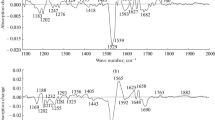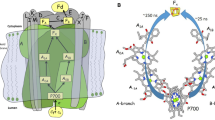Abstract
In this communication, we report our progress on the development of low-frequency Fourier transform infrared (FTIR) spectroscopic techniques to study metal-substrate and metal-ligand vibrational modes in the Photosystem II/oxygen-evolving complex (PS II/OEC). This information will provide important structural and mechanistic insight into the OEC. Strong water absorption in the low-frequency region (below 1000 cm−1), a lack of suitable materials, and temperature control problems have limited previous FTIR spectroscopic studies of the OEC to higher frequencies (>1000 cm−1). We have overcome these technical difficulties that have blocked access to the low-frequency region and have developed successive instruments that allow us to move deeper into the low-frequency region (down to 350 cm−1), while increasing both data accumulation efficiency and S/N ratio. We have detected several low-frequency modes in the S2/S1spectrum that are specifically associated with these two states. Our results demonstrate the utility of FTIR techniques in accessing low-frequency modes in Photosystem II and in proteins generally.
Similar content being viewed by others
References
Berthold DA, Babcock GT and Yocum CF (1981) A highly resolved oxygen-evolving Photosystem II preparation from spinach thylakoid membranes. FEBS Lett 134: 231–234
Berthomieu C, Hienerwadel R, Boussac A, Nabedryk E, Breton J and Diner B (1998) Hydrogen bonding of redox-active tyrosine Z of Photosystem II probed by FTIR difference spectroscopy. Biochemistry 37: 10547–10554
Chu H-A, Nguyen AP and Debus RJ (1995a) Amino acid residues that influence the binding of manganese or calcium to Photosystem II. 1. The lumenal inter-helical domains of the D1 polypeptide. Biochemistry 34: 5839–5858
Chu H-A, Nguyen AP and Debus RJ (1995b) Amino acid residues that influence the binding of manganese or calcium to Photosystem II. 2. The carboxy terminal domains of the D1 polypeptide. Biochemistry 34: 5859–5882
Chu H-A, Gardner MT, O'Brien JP and Babcock GT (1999) Low-frequency Fourier transform infrared spectroscopy of the oxygen-evolving and quinone acceptor complexes in Photosystem II. Biochemistry 38: 4533–4541
Ghanotakis DF and Babcock GT (1983) Hydroxylamine as an inhibitor between Z and P680 in Photosystem II. FEBS Lett 153: 231–234
Gardner MT (1997) Vibrational studies of metalloproteins and related model compounds. PhD dissertation, Michigan State University
Griffiths PR and de Haseth JA (1986) Fourier Transform Infrared Spectroscopy. John Wiley & Sons, New York
Haumann M and Junge W (1999) Photosynthetic water oxidation: a simplex-scheme of its partial reactions. Biochim Biophys Acta 1411: 86–91
Hawkins GJ, Hunneman R, Gardner MT and Babcock GT (1998) An ultra-wide passband (5–30 μm) filter for FTIR studies of Photosystem II. Infrared Phys Techn 39: 297–306
Hoganson CW and Babcock GT (1997) A metalloradical mechanism for the generation of oxygen from water. Science 277: 1953–1956
Limburg J, Vrettos JS, Liable-Sands LM, Rheingold AL, Crabtree RH and Brudvig GW (1999) A functional model for O-O bond formation by the O2-evolving complex in Photosystem II. Science 283: 1524–1527
MacDonald GM and Barry BA (1993) A difference Fourier transformed infrared study of two redox-active tyrosine residues in Photosystem II. Proc Natl Acad Sci USA 90: 11024–11028
Mishra RK and Ghanotakis DF (1994) Selective extraction of CP-26 and CP-29 proteins (33, 23, and 17 Kda) and the DCMU sensitivity of a photosystem II core complex. Photosynth Res 42: 37–42
Noguchi T and Inoue Y (1995) Direct detection of a carboxylate bridge between Mn and Ca2+ in the photosynthetic oxygen-evolving center by means of Fourier transform infrared spectroscopy. Biochim Biophys Acta 1228: 189–200
Noguchi T, Ono T and Inoue Y (1992) Detection of structural-changes upon S1 to S2 transition in the oxygen-evolving manganese cluster in Photosystem II by light-induced Fourier transform infrared spectroscopy. Biochemistry 31: 5953–5956
Noguchi T, Inoue Y and Tang X-S (1997) Structural coupling between the oxygen-evolving Mn cluster and a tyrosine residue in Photosystem II as revealed by Fourier transform infrared spectroscopy. Biochemistry 36: 14705–14711
Noguchi T, Inoue Y and Tang X-S (1999) Structure of a histidine ligand in the photosynthetic oxygen-evolving complex as studied by light-induced Fourier transform infrared difference spectroscopy. Biochemistry 38: 10187–10195
Pecoraro VL, Baldwin MJ, Caudle T, Hsieh W-Y and Law NA (1998) A proposal for water oxidation in Photosystem II. Pure Appl Chem 70: 925–929
Proshlyakov DA, Pressler MA and Babcock GT (1998) Dioxygen activation and bond cleavage by mixed-valence cytochrome c oxidase. Proc Natl Acad Sci USA 95: 8020–8025
Siegbahn PEM and Crabtree RH (1999) Manganese oxyl radical intermediates and O-O bond formation in photosynthetic oxygen evolution and a proposed role for the calcium cofactor in Photosystem II. J Am Chem Soc 121: 117–127
Smith JC, Gonzlez-Vergara E and Vincent JB (1997) Detection of structural changes upon oxidation in multinuclear Mn-oxo-carboxylate assemblies by Fourier transformed infrared spectroscopy: Relationship to Photosystem II. Inorg Chim Acta 255: 99–103
Tommos C and Babcock GT (1998) Oxygen production in nature: a light-driven metalloradical enzyme process. Accts Chem Res 31:18–25
Wise KW, Grafton AK and Wheeler RA (1997) Trimethyl-p-benzoquinone provides excellent structural, spectroscopic, and thermochemical models for plastoquinone-1 and its radical anion. J. Phys Chem A 101: 1160–1165
Yachandra VK, Sauer K and Klein MP (1996) Manganese cluster in photosynthesis: where plants oxidize water to dioxygen. Chem Rev 96: 2927–2950
Zhang H, Razeghifard MR, Fischer G and Wydrzynski T (1997) A time-resolved FTIR study of the plastoquinone QA and redox-active tyrosine YZ interactions in Photosystem II. Biochemistry 36: 11762–11768
Zhang H, Fischer G and Wydrzynski T (1998) Room-temperature vibrational difference spectrum for S2QB −/S1QB of Photosystem II determined by time-resolved Fourier transform infrared spectroscopy. Biochemistry 37: 5511–5517
Author information
Authors and Affiliations
Corresponding author
Rights and permissions
About this article
Cite this article
Chu, HA., Gardner, M.T., Hillier, W. et al. Low-frequency fourier transform infrared spectroscopy of the oxygen-evolving complex in Photosystem II*. Photosynthesis Research 66, 57–63 (2000). https://doi.org/10.1023/A:1010779327960
Issue Date:
DOI: https://doi.org/10.1023/A:1010779327960




